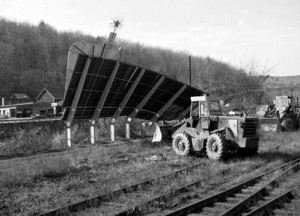
Billboards were common throughout Vermont before the 1968 law that prohibited new billboards and gave owners of existing billboards five years to take them down. This billboard in Montpelier was removed on Oct. 21, 1975, as part of an enforcement action. Vermont State Archives and Records Administration.
Challenge of the times: Vermont’s billboard regulations in the age of digital advertising
Nathaniel Gibson
Correspondent
Editor’s note: This article is the second in a two-part series examining the history of outdoor advertising regulations in Vermont and how they are applied today.
As outdoor advertising has become increasingly prevalent across the United States, Vermont’s ban on billboards has been instrumental in preserving the scenic beauty of the state. Crafted by the Senate Natural Resources Committee in 1968, the law’s aim was to balance preservation of the state’s landscape with the need for informational signs to help the influx of out-of-state visitors. The law established the Travel Information Council to regulate off-premise signs and maintain informational facilities and displays for tourists.
Today, the law’s original goals remain the same. “We need to provide information to the traveler, but do not want to compromise our natural scenery,” says John Kessler, chair of the Travel Information Council. “Tourism is the number one industry in the state. And the lack of advertising is one of the most commonly reported things that visitors appreciate about Vermont.”
Businesses may display an on-premise sign up to 150 square feet, provided that it is not primarily aligned towards a limited access road. Off-premise signs — the official name for billboards — are not allowed, unless TIC grants an exemption. Exemptions are typically granted for reasons of public safety and convenience.
For example, black and white official business directional signs (OBDS) providing distances and directions to local business are allowed. Businesses willing to cover the costs of installation may apply to the Agency of Transportation for these signs.
Also exempted are approach signs, which are placed on the same road as a business and indicates its distance. Approach signs are only approved if there are immediate safety considerations, such as a sharp curve or hill near the business. Additionally, on limited access highways certain signs are required by federal regulations. A complete list of exempt signs can be found in 10 V.S.A. § 494.
Enforcement of the ban begins on a local level. The district transportation office responds to violations by notifying offenders that they need to remove the offending signs. Such offenses are infrequent and typically due to ignorance of the law.
Once notified, most businesses and individuals readily remove the sign in question. Those who want to keep the sign in place can come before TIC to state their case for an exemption or work out a compromise, such as installing an official business directional sign or an approach sign.
Kessler reports that, fortunately, regulation and enforcement do not demand a disproportionate amount of TIC’s time when it meets every other month.Aside from considering exemptions to the off-premise sign ban, the TIC also oversees certain interstate signs to make sure that they meet federal regulations.
While the goals of the law remain the same, times have changed. Advances in sign technology have presented challenges to the law. As flashing displays came into the use during the 1970s, TIC had to decide how to best regulate them.
In 1977, the Travel Information Council, working with the attorney general, established the definition for flashing displays by settling on 15 minutes as the fastest acceptable rate of change. A key factor in that determination was that a traveler’s pace of movement — depending on whether the traveler is on foot or in a vehicle — affects the number of impressions that the traveler sees in a given amount of time. Exempted from this new regulation were certain flashing displays with historical significance, such as barber polls and theater marquees, or others related to public convenience, such as time and temperature signs on banks.
Once defined and regulated, flashing displays have not posed much of an issue for TIC. As with static signs, there have been a few violations. Owners of signs in question are usually happy to remedy the situation. For example, a number of drugstores in Rutland once had flashing displays with messages that were rotating faster than once every 15 minutes — but once notified and made aware of the law, the owners agreed to simply reprogram the displays.
However, recently an electronic business sign at a truck dealership in Jericho has been generating controversy. The owner, Randy H. Clark, has been notified that his sign violates the billboard law. So far Clark has refused to acquiesce, on the grounds that the sign displays messages about charitable endeavors, community events, fund-raisers and birthdays. Clark points out that anyone within the community may contact him about posting such an event, and the service is provided free of charge.
Those who avail themselves of Clark’s display are urged to donate to “Clark’s Community Fund.” According to Clark, all donations go to charitable causes. However, John LaBarge, the AOT’s representative on TIC, is concerned that Clark is charging people to display messages much like the owner of a billboard displays advertisements for a business in return for a fee.
In response to the situation in Jericho, the House Transportation Committee has asked TIC to review and update the current regulations governing flashing, intermittent signs. TIC submitted its report on current exemptions on Jan. 15 in which it recommended a number of minor changes primarily aimed at increasing the clarity and cohesiveness of the law’s language. TIC also recommended that “sandwich boards and other similarly temporary advertising signs may be erected if they are regulated by municipal ordinances.”
TIC must adopt the updated rules for flashing, intermittent or moving lights by July 1. Kessler, well aware of the significance of this process, observes, “I think the law governing off-premise advertising strikes close to the heart of what Vermonters care about.”
Nathaniel Gibson is a freelance writer who lives in Pawlet. He may be contacted at nathanielrgibson.com.
The article originally appeared in the Rutland Herald and the Times Argus:
April 29, 2012
Section: ENVIRONMENT






